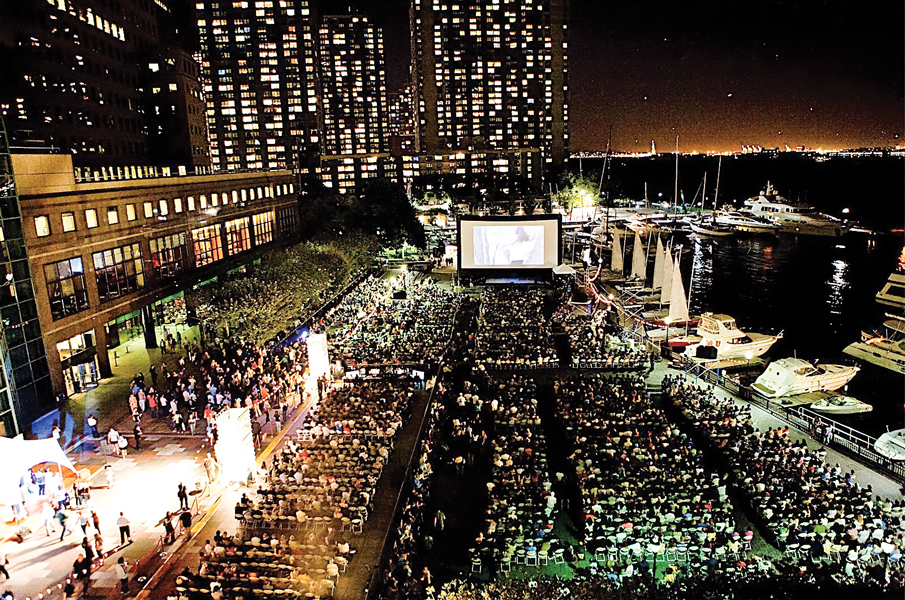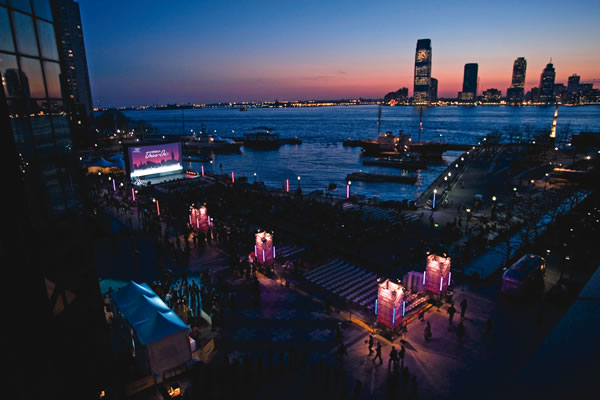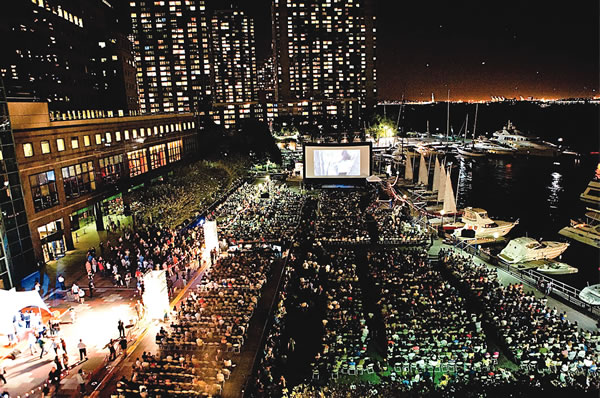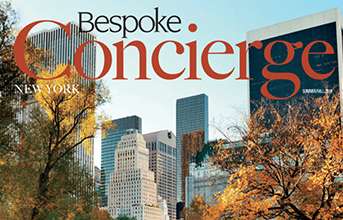Each year, Manhattan’s Tribeca Film Festival captivates with new features, ranging from midnight movies to debut documentaries.
By Linnea Covington
For more than a decade, the Tribeca Film Festival (TFF) has been a main attraction to Lower Manhattan, drawing in millions of people from around the globe for two weeks of movie screenings and celebrations. This spring, from April 17 – 28, the reels start spinning once again as the district prepares for another successful event. Part of the festival’s allure is the mystery surrounding its upcoming films and events—the lineup is kept under wraps until early April.
“The Tribeca Film Festival is about filmmakers, industry and pushing the boundaries of innovation and discovery,” says Genna Terranova, director of programming at TFF. “We are a cultural event that exists in a city that has many cultural events going on.”
At the festival’s first annual event in 2002, 90 films were showcased from both big-name and unknown directors and actors, including Dylan Kidd, a breakout director who won Best Feature Film with the acclaimed “Roger Dodger,” and Raul Marchand-Sanchez, with “12 Hours,” a Puerto Rican film that marked his directorial and screenwriting debut.
Since then, more than 1,300 films from 80 countries have been featured. They broach a variety of subjects from boxing to travel to romance, and come in various forms, from documentaries to narrative features to online shows. The goal, Terranova says, is to showcase a range of subjects and styles.
“All the films picked were watched by a bunch of people, all with different tastes, and they have sat down and agreed that each film is something that should be shared,” she explains. “You can have something like ‘The Avengers’ and an obscure documentary about Romania, and they can live next to each other. It goes back to the diversity of the audience. […] Every film finds its own unique audience here.”
Ready, Set, Action
The Tribeca Film Festival was born from an idea that Robert De Niro, Jane Rosenthal and Craig Hatkoff had to create a film organization. Their decision came on the heels of the World Trade Center attacks on Sept. 11, 2001. At that time, the downtown area was devastated, and they hoped to bring culture and life back to the area.
“It was about rejuvenating downtown, which is an appropriate example of how the festival has grown,” Terranova says. “[The area] has been rebuilt, and the festival too has grown and found its stride over the last 10 years.”
The number of films nearly doubled between 2002 and 2008, until they finally cut it back to the 90 films shown today. Every year, millions of people from around the world come to the city to see what the festival has to offer. While reels about war in the Congo or stories based on a Cuban poem might appear customary for a festival like this, films about New York also have a place in the event. Take Alfredo de Villa’s award-winning narrative feature “Washington Heights,” for example, which debuted the same year as the TFF and showcased the predominantly Dominican neighborhood in upper Manhattan.
“The Tribeca Film Festival is such a unique experience because it gives you a dose of the local and the international, which I suppose is part of the Manhattan experience,” says de Villa, who adds that he never expected to win with “Washington Heights.”
That “Manhattan experience” and exposure from the festival continue to work beyond the TFF, a sentiment shared by other filmmakers like Nisha Pahuja, whose film “The World Before Her,” won Best Documentary Feature in 2012.
“Because we won at the Tribeca Film Festival, it kind of gave us wings and catapulted us,” says the Toronto-based Pahuja. “Now, we have been invited to more than 70 festivals and participated in 60 since April.”
Pahuja got into the festival after receiving funding from the Tribeca Film Institute (TFI), a branch of the TFF that provides grants between $10,000 and $50,000 each year for documentaries. “It’s so difficult to get films off the ground and find funding,” she says. “Grants, like [TBI] are really important.”
Playing it Forward
While the festival draws in around $600 million a year, it gives a lot of those funds back to the filmmakers and helps support the arts. With the Artists Awards program, it also uses art as part of the prize given to winning films. For example, Pahuja received artist Kara Walker’s series of prints called “An Unpeopled Land in Uncharted Waters.” In turn, pleased with the piece, Pahuja sent Walker a copy of her winning film about the controversy of beauty pageants in India.
Documentary films like Pahuja’s are a big part of the festival, but mainstream commercial films have a place as well. Over the past 11 years, popular actors and actresses have had their movies screened at the TFF before going to the big screen, including last year’s “The Five-Year Engagement” starring Emily Blunt and Jason Segel. Julie Delpy’s “2 Days in New York” starring Chris Rock and Morgan Spurlock’s documentary “Mansome,” featuring Jason Bateman, Will Arnett and Paul Rudd, also aired at TFF before appearing in theaters a few weeks later.
Not all films make it to the big screen right away, or at all, for that matter. It’s a perk to see the former before everyone else does, and those—especially foreign films—that don’t make it to the big theaters in the U.S. are a real treat to experience at the festival.
Reel Time, Online
While some features make it to the big screen, others can only be watched online. Merging video and technology, the festival understands the importance of the digital world in the film industry. Last year, director Fredric Golding won Best Online Feature for “On the Mat,” a documentary about high school wrestling; Jerry Rothwell from the U.K. won in 2011 for his feature film “Donor Unknown,” which told the tale of a girl searching for the man who donated his sperm, thus creating her.
“We are the only [film festival] that shows films online, and we have video-on-demand at the same time as the festival,” Terranova says. “As the engagements with films evolve, we evolve, and it’s an exciting time because technology is moving very quickly.”
This is why in 2013, for the first time, the festival is introducing technology with Storyscapes, a lineup of five projects that utilize social media, film, digital tools and other modern machinery to tell a story.
“For me, it’s about what happens when you bring storytelling and technology together, and it’s updating a very old idea about making the watching of the film more immersive,” says Ingrid Kopp, director of digital initiative at the Tribeca Film Institute. “It’s about how you can rethink the audience experience beyond just sitting in the audience watching.”
When it comes to the future goals of TFF, Terranova says that’s all about the stories.
“Storytelling is captivation, and an important part of culture,” she says. “It’s a place where you can get lost for an hour or two in a story, and it’s all about how we find and deliver those stories.”
This year, the Tribeca Film Festival is expected to be no different. An unwavering staple in New York City’s arts culture, the event will surely entertain, educate and inspire filmmakers and film lovers alike.











